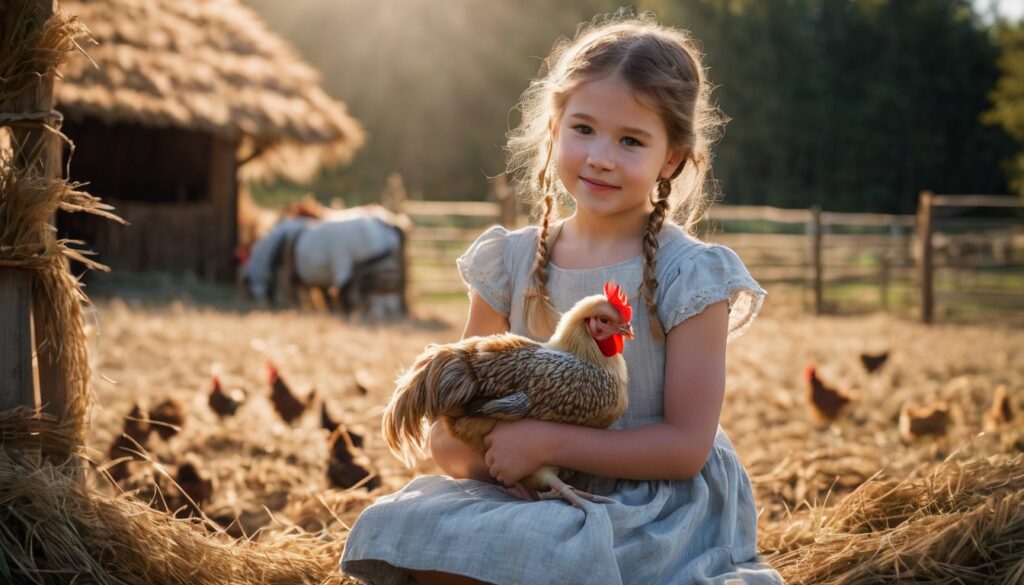Ever found yourself scratching your head, trying to figure out if that fluffy creature in front of you is a chicken or a rooster? You’re not alone! Trust me, it’s not always as easy as pie.
Even seasoned poultry enthusiasts have been known to confuse the two, especially with certain breeds that don’t show clear gender markers until they’ve aged a bit. But hey, there’s no need to fret – I’ve got your back! After taking many deep dives into the world of chickens and having lively discussions with experts who breathe poultry day-in and day-out, I’ve pieced together this reliable guide for you.
So let’s unravel this barnyard mystery together – read on and before you know it, you’ll be separating the hens from the roosters like a pro.
Key Takeaways
- Roosters and hens are different genders of chickens. Roosters have big tails, larger combs, and crow, while hens don’t.
- Auto – sexing through coloration can help determine the gender of chicks based on their feather colors or patterns.
- Sexual dimorphism allows easy differentiation between roosters and hens by looking at physical characteristics like comb size and tail feathers.
- Vent sexing is a method used to determine chick gender by examining their vents but should only be done by professionals.
Understanding Roosters and Hens
Roosters and hens are the two main genders of chickens, with distinct differences in their biology, behavior, and reproduction.
The difference between roosters and hens
Roosters and hens are both chickens, but they are not the same. Roosters are males and hens are females. They look different from each other too. Roosters have big tails with long, shiny feathers.
Hens do not have these kinds of tails. You will also see that roosters have bigger combs on their heads than hens. Not just this, roosters crow while hens don’t! Next time you see a chicken, try to guess if it’s a hen or a rooster!
Terminology and biology
Chickens have their own special terms and biology. For example, a male chicken is called a rooster or cock, while a female chicken is called a hen. When chickens are young, the males are called cockerels and the females are called pullets.
In terms of biology, chickens belong to the bird family Gallus gallus domesticus. They were domesticated from wild jungle fowl around 8,000 years ago in Southeast Asia. Since then, they have been bred and hybridized to create different breeds with certain characteristics.
Chickens also have unique behaviors and reproductive habits. Roosters are known for their crowing sound early in the morning to mark their territory and attract mates. Hens can lay eggs without needing a rooster, but if one is present, they may fertilize the eggs leading to chicks hatching later on.
Behavior and reproduction
Chickens have unique behaviors and reproductive patterns. Roosters are known for their crowing, which they often do in the early morning to mark their territory and communicate with other chickens.
They also have a tendency to be more aggressive compared to hens, displaying dominance through displays of puffing up their feathers and standing tall. When it comes to reproduction, roosters play an important role by mating with hens to fertilize eggs.
Hens then lay the eggs and incubate them until they hatch into chicks. It’s fascinating how these behaviors and reproductive processes contribute to the natural cycle of life for chickens.
Origin and domestication
Chickens have been domesticated for thousands of years and are believed to have originated from the red jungle fowl in Southeast Asia. People started keeping chickens for their eggs, meat, and feathers.
Over time, different breeds were developed through selective breeding for specific traits. Today, there are numerous chicken breeds with various characteristics and appearances. Domestication has allowed us to raise chickens in our backyards and farms, providing a sustainable source of food and companionship.
Physical Differences between Roosters and Hens
Learn how to tell the difference between roosters and hens through various methods such as auto-sexing, sexual dimorphism, and vent sexing. Discover the physical characteristics that distinguish these two poultry species and gain valuable insights into identifying them in popular chicken breeds.
Auto-sexing through coloration
Auto-sexing is a way to tell the difference between chickens and roosters just by looking at their coloration. Some chicken breeds have specific patterns or colors that make it easier to determine their gender.
For example, certain breeds may have different colored feathers on their wings or head when they are chicks. This makes it possible to identify which ones are males (roosters) and which ones are females (hens).
So, if you’re not sure whether your fluffy little chick is a chicken or a rooster, take a close look at its feathers and see if there are any distinct color differences that can help you figure it out.
In auto-sexing through coloration, one of the key factors to consider is the pattern of markings on the chick’s body. Some breed-specific characteristics include certain spots or stripes that appear differently in male and female chicks.
These unique markings allow breeders, farmers, and enthusiasts to sex chicks accurately from an early age. It’s important to note that while some breeds may be more easily auto-sexed through coloration, this method might not work for all types of chickens.
Sexual dimorphism
One important way to tell the difference between chickens and roosters is through sexual dimorphism. This means that males and females of a species have distinct physical characteristics.
In the case of chickens, roosters typically have larger combs and wattles compared to hens. They also tend to have longer and more prominent tail feathers, which they use for attracting mates.
On the other hand, hens usually have smaller combs and wattles, as well as shorter tail feathers. By looking at these physical differences, you can easily determine whether a chicken is a rooster or a hen.
Vent sexing
Vent sexing is a method to determine the gender of chickens by examining their vents, which is the opening for waste elimination. This technique can be done when the chicks are very young.
By looking closely at the size and shape of the vent, experts can identify whether it’s a male or female chick. Vent sexing requires experience and knowledge because it’s not easy to do accurately.
It is commonly used in commercial poultry operations to separate male and female chicks for various purposes, such as egg production or meat production. However, vent sexing should only be done by trained professionals due to its complexity and potential harm if not performed correctly.
Physical characteristics
When trying to differentiate between chickens and roosters, one of the key ways to do so is by looking at their physical characteristics. These can include features such as comb size and shape, wattles (the fleshy lobes hanging down from the lower side of a chicken’s head), feather patterns, and reproductive organs.
For example, roosters typically have larger combs and wattles compared to hens. Additionally, their feathers may be more vibrant in color or have distinctive patterns. It’s also important to note that certain breeds may have unique physical characteristics that make it easier to distinguish between roosters and hens.
Remember that tail feathers are often a more reliable indicator of a rooster compared to other physical attributes like hackle or saddle feathers.
Identifying Roosters and Hens in Popular Chicken Breeds
When it comes to identifying roosters and hens in popular chicken breeds, there are a few key physical characteristics to look out for.
Silkie
Silkie chickens are a popular breed known for their fluffy feathers. When it comes to determining the gender of Silkies, there are a few key features to look for. The first is the size and shape of their combs and wattles.
Roosters typically have larger and more prominent combs and wattles compared to hens. Additionally, roosters also tend to have longer saddle feathers on their backs compared to hens.
So if you’re trying to figure out whether your Silkie is a hen or rooster, pay attention to these physical attributes!
Barred Rock
Barred Rock chickens, also known as Plymouth Rocks, are a popular breed for backyard flocks. They have distinct black and white striped feathers that make them easy to identify. When it comes to determining if a Barred Rock is a rooster or a hen, there are some key characteristics to look for.
Roosters tend to have larger combs and wattles compared to hens. Additionally, roosters usually have longer, more pronounced tail feathers compared to hens. So if you see a Barred Rock with a large comb, prominent wattles, and long tail feathers, chances are it’s a rooster.
On the other hand, if the chicken has smaller combs and wattles and shorter tail feathers, it’s likely a hen.
Rhode Island Red
The Rhode Island Red is a popular breed of chicken known for its hardiness and excellent egg-laying abilities. When it comes to differentiating between roosters and hens, there are a few key characteristics to look out for in this breed.
The male Rhode Island Reds, or roosters, tend to have larger combs and wattles compared to the females, or hens. They also have longer and more curved sickle feathers on their tails.
In contrast, the hens have smaller combs and wattles with shorter tail feathers. These physical differences can help you identify whether a Rhode Island Red is a rooster or a hen.
Ameraucana
For the Ameraucana breed of chickens, there are a few key physical characteristics that can help you distinguish between roosters and hens. One important feature to look at is their comb.
Roosters tend to have a larger and more prominent comb compared to hens. Additionally, their wattles, which are the fleshy lobes hanging down from the sides of their head, are usually bigger and redder in roosters.
Another characteristic to consider is feather coloration. Ameraucanas come in various colors, but both roosters and hens typically have similar patterns and shades. However, it’s worth noting that roosters may exhibit more vibrant or intense colors compared to hens.
When it comes to behavior, keep an eye out for signs of aggression or dominance. Roosters tend to be more territorial and protective than hens. They may engage in behaviors such as crowing loudly or puffing up their feathers when they feel threatened or want to assert themselves.
Easter Egger
Easter Eggers are a popular breed of chicken known for their colorful eggs. They are often mistaken for Ameraucanas or Araucanas because they can lay blue or green eggs. However, Easter Eggers are actually a mixed breed, which means they can have different physical appearances and temperaments.
Some Easter Eggers may have fluffy cheeks and beards, while others may not. Their feather colors can also vary greatly, ranging from black to brown to white. Despite their diverse characteristics, one thing remains consistent – Easter Eggers are excellent layers of beautiful eggs!
Buff Orpington
Buff Orpingtons are popular chicken breeds known for their beautiful golden buff color. When it comes to differentiating between roosters and hens, Buff Orpingtons have a few key physical characteristics to look out for.
Roosters typically have larger and more pronounced combs and wattles compared to hens. Additionally, roosters may also display longer tail feathers with a slight curve at the end. On the other hand, hens tend to have smaller combs and wattles, as well as shorter tail feathers that are less curved.
Remembering these visual cues can help you identify whether your Buff Orpington is a rooster or a hen without any confusion.
Polish
Polish chickens are a popular breed known for their unique appearance. They have crests on top of their heads, which can make it easier to identify them as roosters or hens. The crest in roosters is often larger and more extravagant compared to hens.
Additionally, the neck feathers, known as hackle feathers, in Polish roosters tend to be longer and more prominent than those of hens. These differences in crest size and hackle feather length can help determine whether a Polish chicken is a rooster or a hen.
So if you’re trying to figure out the gender of your Polish chicken, pay close attention to these characteristics!
Silver-laced Wyandotte
The Silver-laced Wyandotte is a popular chicken breed known for its beautiful silver and black feather pattern. It is relatively easy to tell the difference between roosters and hens in this breed.
As chicks, male Silver-laced Wyandottes usually have larger combs and wattles compared to females. When they mature, roosters will develop long, graceful sickle feathers on their tails while hens will have shorter, rounder feathers.
Roosters also tend to be more assertive and may exhibit protective behavior towards the flock. Overall, the Silver-laced Wyandotte is a stunning breed that can be easily identified based on specific physical characteristics.
Pros and Cons of Keeping Roosters
Having a rooster in your flock can provide several benefits, such as maintaining balance in the flock, providing defense against predators, and serving as an alarm clock with their crowing.
However, it’s important to consider the potential downsides too, including aggression towards other birds and noise concerns.
Reasons to have a rooster
Having a rooster in your flock can bring several benefits. Firstly, a rooster helps maintain balance in the flock by establishing a hierarchy and keeping order among the chickens. They also act as protectors, alerting the hens to potential dangers and defending them against predators.
Additionally, having a rooster adds a sense of natural harmony to your backyard with their crowing in the morning. Their presence can enhance the overall ambiance of your poultry setup and create a more authentic farm experience.
Balance in the flock
Having a balance in your flock of chickens is important for various reasons. One key reason is that roosters can provide protection against predators. They are more alert and will sound the alarm if they sense any danger, keeping the hens safe.
Additionally, having a rooster in the flock ensures natural reproduction, as they play a vital role in fertilizing eggs. However, it’s important to note that too many roosters can lead to aggression and fighting among them, which can be harmful to both the roosters and hens.
Therefore, maintaining a proper ratio of roosters to hens is crucial for harmony within the flock. By striking this balance between male and female chickens, you can ensure the well-being and productivity of your entire poultry community without any unnecessary conflicts or disruptions.
Defense against predators
Keeping a rooster in your flock can provide valuable defense against predators. Roosters have a natural instinct to protect their hens and will sound the alarm if they sense danger.
They are often more vigilant and aggressive when it comes to defending their territory, making them an important asset for ensuring the safety of your chickens. With their loud crowing and ability to alert the flock, roosters serve as a deterrent to potential predators such as foxes, raccoons, and even neighborhood cats.
Their presence can help keep these predators at bay and give you peace of mind knowing that your chickens are protected.
Crowing
Roosters have a unique behavior that sets them apart from hens – crowing. Yes, you’ve probably heard roosters crowing in the morning! It’s their way of announcing themselves and claiming their territory.
Roosters often start crowing at around four to five months old and continue throughout their lives. The sound can be loud and piercing, as they use it to communicate with other chickens and establish dominance.
So, if you hear a chicken making those distinctive “cock-a-doodle-doo” sounds, you can be certain it’s a rooster!
Conclusion
In conclusion, this guide has provided you with everything you need to know about differentiating between chickens and roosters. From understanding their behaviors and physical characteristics to identifying them in popular chicken breeds, you now have the knowledge to distinguish between hens and roosters with confidence.
Whether you’re a backyard chicken owner or simply interested in poultry, this definitive guide will help you navigate the world of chickens and roosters.
FAQs
1. What is the difference between chickens and roosters?
Chickens are farm animals that may be female or male, while roosters, also called cocks, are adult male chickens.
2. How can I tell a chicken’s gender for animal husbandry?
Gender identification in chickens involves observing their appearance and behavior. Roosters usually have larger combs than hens do.
3. Can you explain what a capon is?
A capon is an altered male chicken made to grow bigger and fatter which improves the taste of its meat as compared to normal roosters.
4. Is it okay for different types of poultry to share a chicken coop?
Yes! As long as there’s enough space for them all; even hybridization among various breeds is possible within one coop if managed properly.





